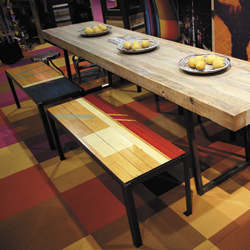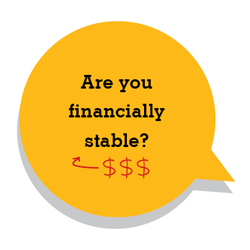 |
 Candy Adams,
Candy Adams,
CTSM, CME,
CEM, CMP, CMM,
is an independent exhibit-management
consultant, trainer, speaker, writer, and an Exhibitor conference
faculty member.
CandyAdams
@BoothMom.com
|
| |
 n the early '90s, when I started working in the trade show industry, carpet was king. No one really used any other kind of exhibit flooring. In fact, the exhibitor services manual often required exhibitors to carpet their booths. We had no choice. n the early '90s, when I started working in the trade show industry, carpet was king. No one really used any other kind of exhibit flooring. In fact, the exhibitor services manual often required exhibitors to carpet their booths. We had no choice.
Now, however, exhibit flooring choices abound - from wood and
vinyl to sisal and sea grass - allowing you to differentiate your booth amid aisle upon aisle of carpet.
Although carpet is still usually the least expensive flooring option up front, alternative flooring, such as vinyl or plastic tiles, is often lighter to ship than carpet and more modular, and it may be faster to install than traditional pad and carpet. Also, depending on the union jurisdiction, if no tools are required to lay it, the exhibitor may be able to install it without union labor. Alternative flooring may also be more durable than carpet, so you can use it longer. And with all the flooring options currently on the market, you're likely to find one that meets your needs - as long as you know what to look for.
Options to Choose From
Before you ditch traditional carpet, consult this list of commonly used alternatives to learn more about each option. It's followed by a list of questions to ask your vendor if you decide to go against the carpet grain.
 Foam Squares. Interlocking foam-rubber squares were one of the first alternatives to exhibit carpeting. They are lightweight and easy to ship, come Foam Squares. Interlocking foam-rubber squares were one of the first alternatives to exhibit carpeting. They are lightweight and easy to ship, come
in a large variety of colors, are easy to snap together like the pieces of a child's puzzle, and are easy on your exhibit staff's feet, with more cushioning than the average unpadded carpet. They're also considered one of the most environmentally friendly types of flooring since they can be made from recycled rubber. Foam squares also can be the least expensive flooring option, with prices as
low as $0.60 per square foot.
One of the downsides of the foam squares is that depending on the materials used in manufacturing, many of them need to be laid after they have been at room temperature for 24 hours; otherwise, there is a potential for damage to the connectors. So if you're shipping them to a hot venue during summer months, or a cold venue during winter months, they might need to sit inside the convention
center for up to a full day before you begin interlocking them.
 Wood Flooring. Wood flooring comes in a variety of wood grains, colors, and finishes. The most common wood flooring for exhibits comes in planks that fit together with tongue-and-groove fasteners or slide and snap together, or tiles that come in 1-yard or 1-meter squares that drop into a metal frame. Wood floors typically cost anywhere from $5 to $15 per square foot, depending on the quality, type, and width of the wood planks. Wood Flooring. Wood flooring comes in a variety of wood grains, colors, and finishes. The most common wood flooring for exhibits comes in planks that fit together with tongue-and-groove fasteners or slide and snap together, or tiles that come in 1-yard or 1-meter squares that drop into a metal frame. Wood floors typically cost anywhere from $5 to $15 per square foot, depending on the quality, type, and width of the wood planks.
One difficulty of using a wood floor is that it often requires an extensive
underlying subfloor to support it, which adds time, materials, and labor. And because it's often ambiguous whether the carpenters, decorators, or carpet layers have union jurisdiction to build the subfloor, you may have the added hassle and time of resolving a labor dispute.
Reusing wood floors can also be difficult, because the location of the holes you have to drill for electrical and other cables may vary from show to show. While carpeting can simply be patched, drilled planks usually have to be replaced. I've even had
laborers who thought a bigger hammer would help connect non-connecting planks and inadvertently damaged the tongue-and-groove connections between them.
 Plastic Tiles. Plastic floor tiles come in a variety of different surface styles and more than a dozen standard colors, and in patterns from industrial-metal-looking diamond-plate tiles to faux wood. If you're willing to pay a little more, you can even get the manufacturer to create exact colors to match your exhibit or corporate colors. Plastic Tiles. Plastic floor tiles come in a variety of different surface styles and more than a dozen standard colors, and in patterns from industrial-metal-looking diamond-plate tiles to faux wood. If you're willing to pay a little more, you can even get the manufacturer to create exact colors to match your exhibit or corporate colors.
Installing interlocking plastic tiles is easy, often not even requiring tools. To alleviate a potential tripping hazard and comply with the Americans with Disabilities Act (ADA) regulations, you can order sloped edging to transition between the tile and concrete floor in the exhibit hall. Depending on color and surface style, plastic tiles can range from $2 to $10 per square foot.
Plastic tiles can be slippery, especially when they are wet. So if you serve beverages in your exhibit, have water features (such as fountains) on display, or product demos that incorporate water or other liquids, you might want to consider perforated plastic tiles made of a type of polypropylene. The perforation in the tiles allows liquids to pass through your flooring rather than pooling on top of it - thus eliminating a potential slipping hazard.
 Rollable Vinyl Flooring. This flooring is usually a foam pad covered with a ribbed, diamond-plate, or wood-grain top layer and laminated in polyurethane. It comes in a number of thicknesses, widths, and lengths and is simply unrolled in your exhibit and taped to the floor. Vinyl flooring is inexpensive, from $1 to $6 per square foot. However, since it comes in either 5- or 10-foot widths (depending on the manufacturer), it can be difficult to transport, and any damage to it may make the entire roll unusable. Rollable Vinyl Flooring. This flooring is usually a foam pad covered with a ribbed, diamond-plate, or wood-grain top layer and laminated in polyurethane. It comes in a number of thicknesses, widths, and lengths and is simply unrolled in your exhibit and taped to the floor. Vinyl flooring is inexpensive, from $1 to $6 per square foot. However, since it comes in either 5- or 10-foot widths (depending on the manufacturer), it can be difficult to transport, and any damage to it may make the entire roll unusable.
 Green Flooring. Green flooring options are expanding as demand increases. Some options include linoleum, bamboo wood flooring, and various types of flooring made from recycled rubber tires, corn, cork, sea grass, sisal, straw, and even coir, a rough fiber found on the outside husk of a coconut. These options vary dramatically in pricing, depending on the material used. But, as a general rule, the more Green the flooring (and the more recycled materials used to produce it), the higher the price. Green Flooring. Green flooring options are expanding as demand increases. Some options include linoleum, bamboo wood flooring, and various types of flooring made from recycled rubber tires, corn, cork, sea grass, sisal, straw, and even coir, a rough fiber found on the outside husk of a coconut. These options vary dramatically in pricing, depending on the material used. But, as a general rule, the more Green the flooring (and the more recycled materials used to produce it), the higher the price.
Questions to Ask
If you choose to abandon traditional carpet in favor of something slightly more exotic, forget what you thought you knew about flooring and learn a new set of skills. After all, everything from installation and edging options to maintenance and wire management are likely to be different with recycled rubber tires than with the carpet and pad options with which you're familiar. To help you navigate the transition, here are several questions to ask your vendor before committing to a carpet alternative.
1. What is the expected life of the product, and does it come with a warranty? What does the warranty really cover, and what is considered "normal wear?" Knowing how long the floor will last will help you predict and evaluate the price per show.
2. What additional percentage of spare tiles or planks should I maintain in case of damage or breakage? Will heavy exhibit properties leave pressure marks that could permanently damage the floor, rendering it unusable in just one show? Also find out if you can get a case or a special pallet to protect the edges of your planks or tiles, which are vulnerable to damage
en route. The value of all your flooring goes down the tubes if you damage one too many planks during shipping or installation, and have to resort to last-minute rental carpet to cover your concrete. So always have extra on hand to allow for a reasonable amount of damage or breakage
during each show you attend.
3. How will the flooring work with under-floor utilities, such as electrical wiring or cabling for Internet, audio, or video? Will you need to install a subfloor? Depending on the size of the cable, will wiring cause problems with maintaining the adhesion of the fasteners between the tiles? Or will under-floor wires cause an uneven surface and subsequent trip hazards? Installing a subfloor under your visible flooring can more than double your labor cost if it's complex to assemble. So be sure you know whether or not a subfloor is required before you commit to a flooring option you ultimately won't be able to afford.
4. What is the best way to bring cables up through the flooring? What type of tool is required to cut it? Can it be repaired after cutting or do cut pieces need to be replaced?
5. What is the weight per tile or piece? Determine how the weight and dimensions of your flooring freight will affect your bottom-line exhibit-transportation, material-handling, and storage costs.
6. How long does it take to install per 100 square feet? This will help you estimate ongoing labor costs associated with the flooring. If possible, ask for a setup demonstration, so you understand the subfloor system, how to run cables through it, how to lay the actual flooring, and how to finish its edges. It's important to really understand what you'll need to do at the show, since your laborers may not have installed that particular kind of flooring before.
7. How are the edges finished? Will you need to order sloped edging to cover the exposed edges of your flooring to keep people from tripping as they enter your booth space? Do you need to use double-sided tape to hold down the edges of your flooring, especially where your exhibit space meets the main aisle(s)? ADA regulations are very specific about the grade of any slope of flooring to allow those with mobility vehicles full access to a booth space.
8. What will it take to keep the floor looking its best? Finding cleaning labor that knows how to do anything but vacuum carpet can be a challenge, especially if you need a particular cleaning product, or if traditional cleaners can damage the material you choose. So come prepared with any necessary cleaning products and tools if typical options are not appropriate for your flooring.
9. Can I see flooring samples before making a purchase? Matching your exhibit laminate, paint color, or logo to a flooring sample on a computer screen can be deceptive. I found this out the hard way when renting flooring
from a Las Vegas exhibit house. I ended up with glow-in-the-dark royal blue when I asked for medium blue.
Regardless of the material you choose, a unique floor covering can help you stand out in a sea of sameness, while also reinforcing your brand's personality. Bottom line, don't be afraid to step outside the confines of rental carpet - and never underrate what's underfoot.e
|





 n the early '90s, when I started working in the trade show industry, carpet was king. No one really used any other kind of exhibit flooring. In fact, the exhibitor services manual often required exhibitors to carpet their booths. We had no choice.
n the early '90s, when I started working in the trade show industry, carpet was king. No one really used any other kind of exhibit flooring. In fact, the exhibitor services manual often required exhibitors to carpet their booths. We had no choice.


